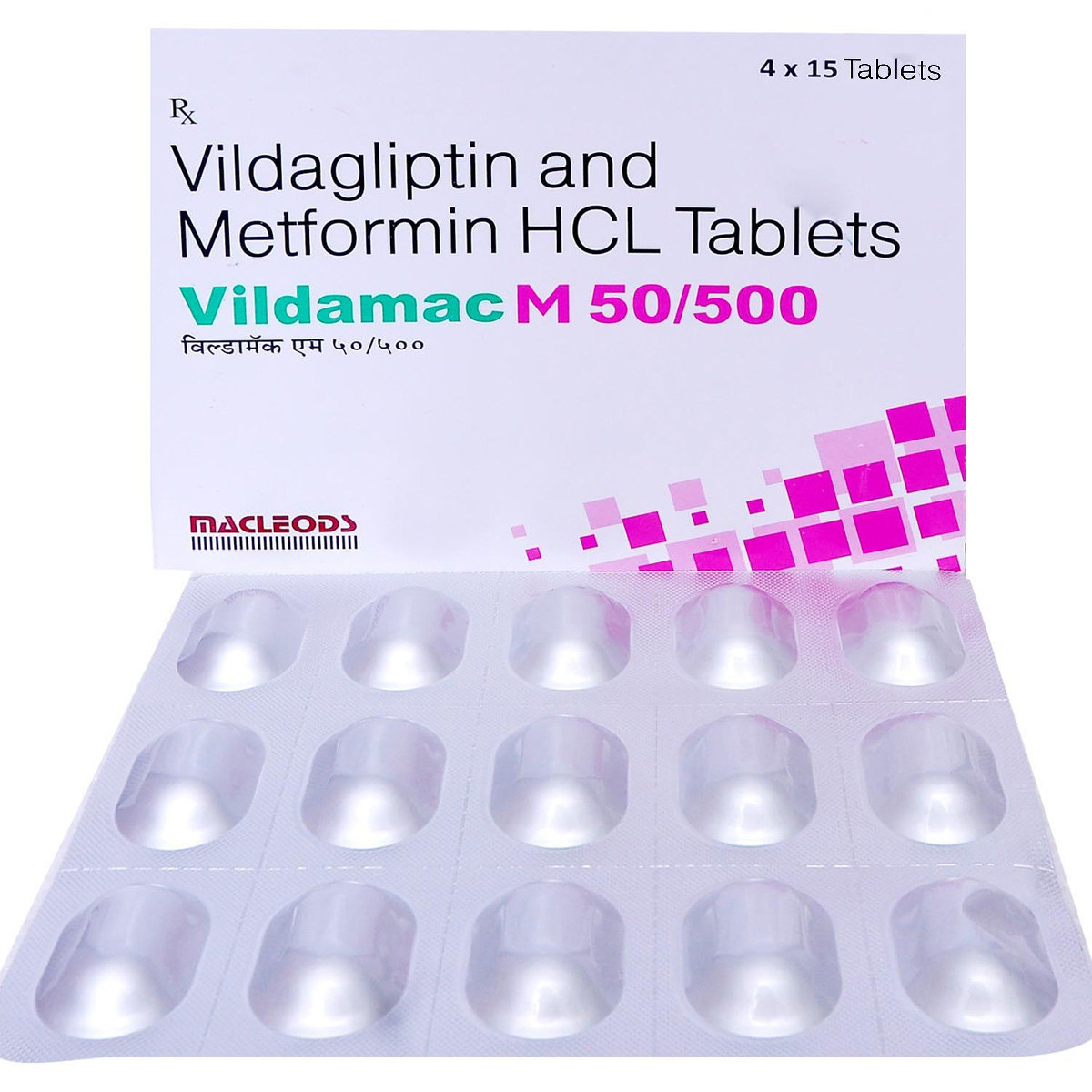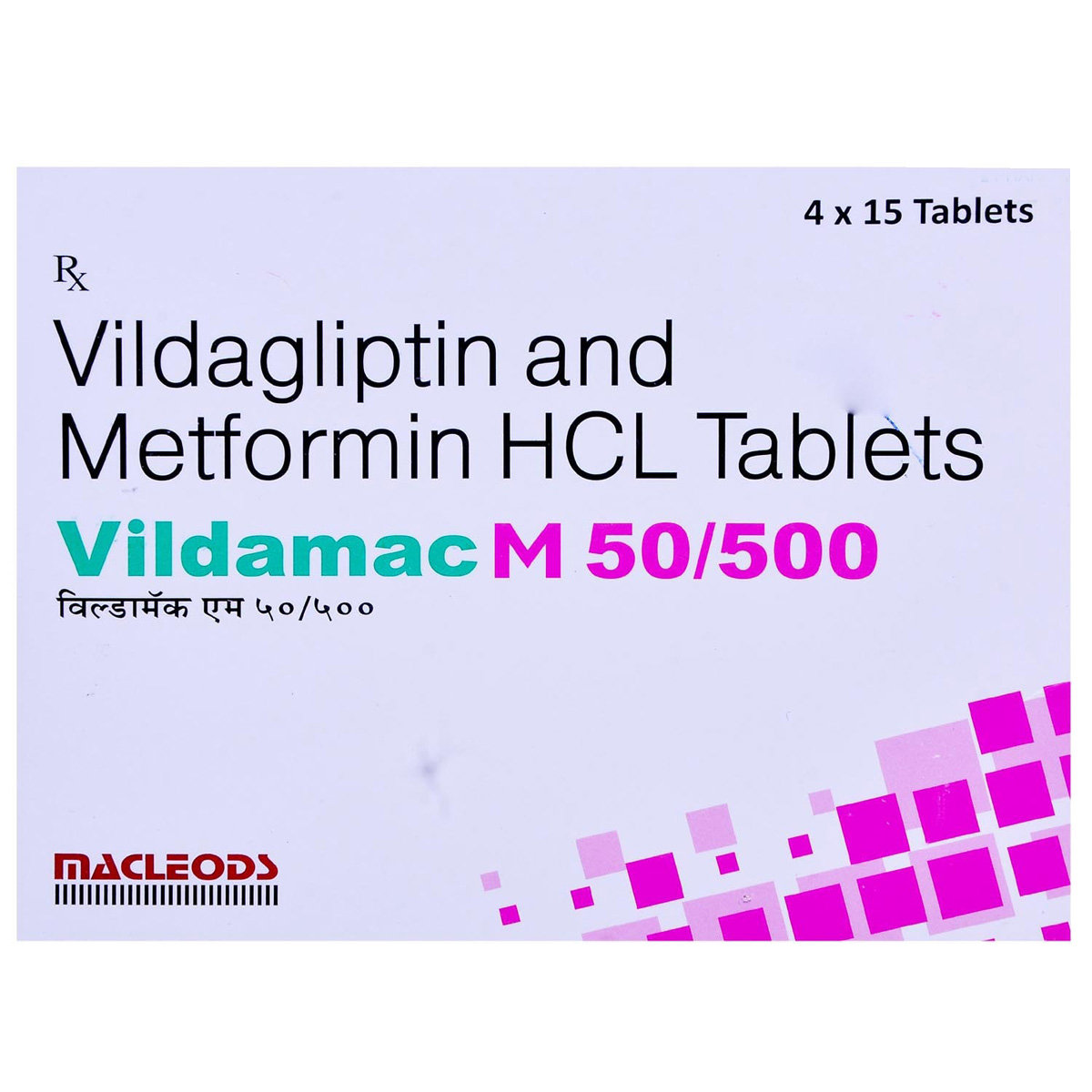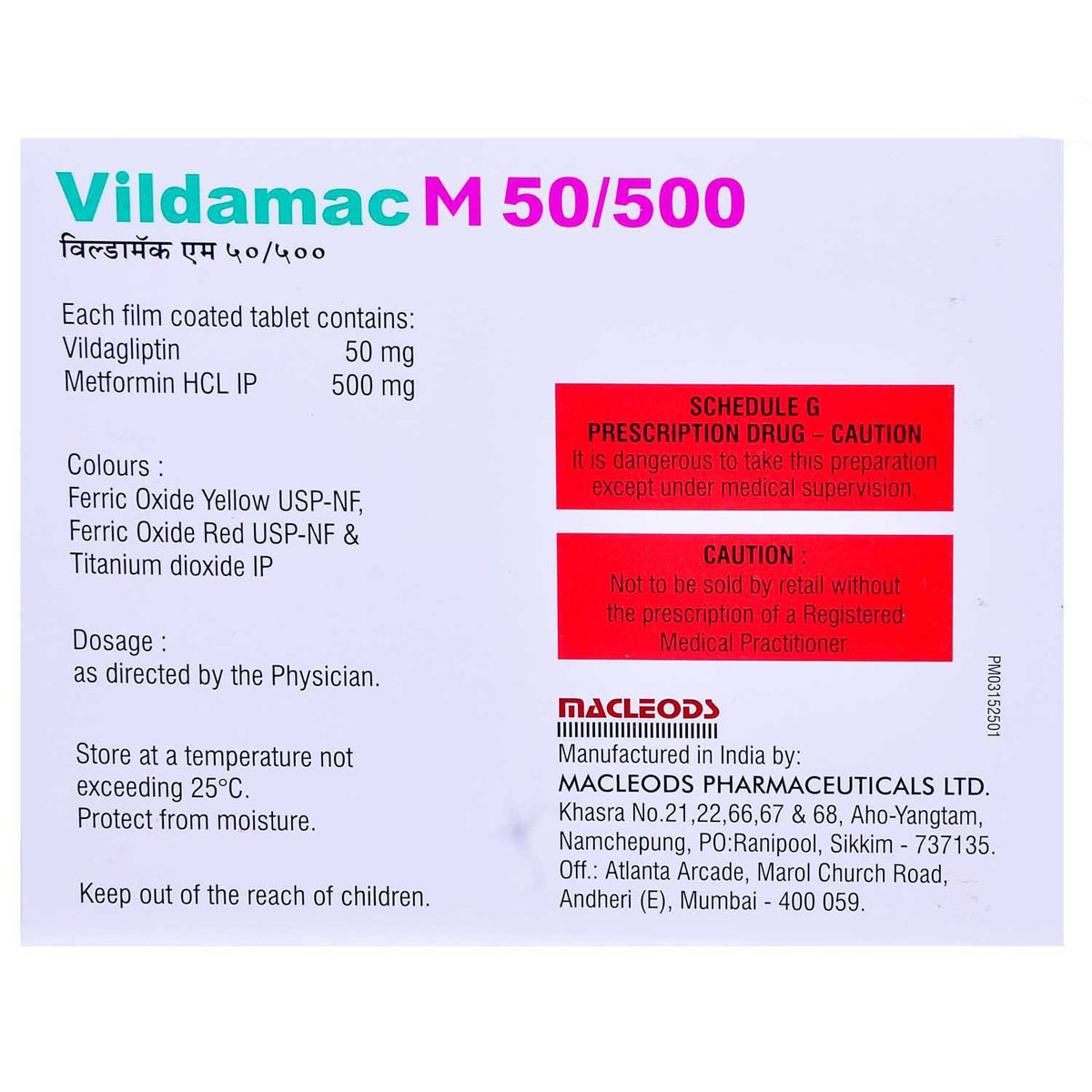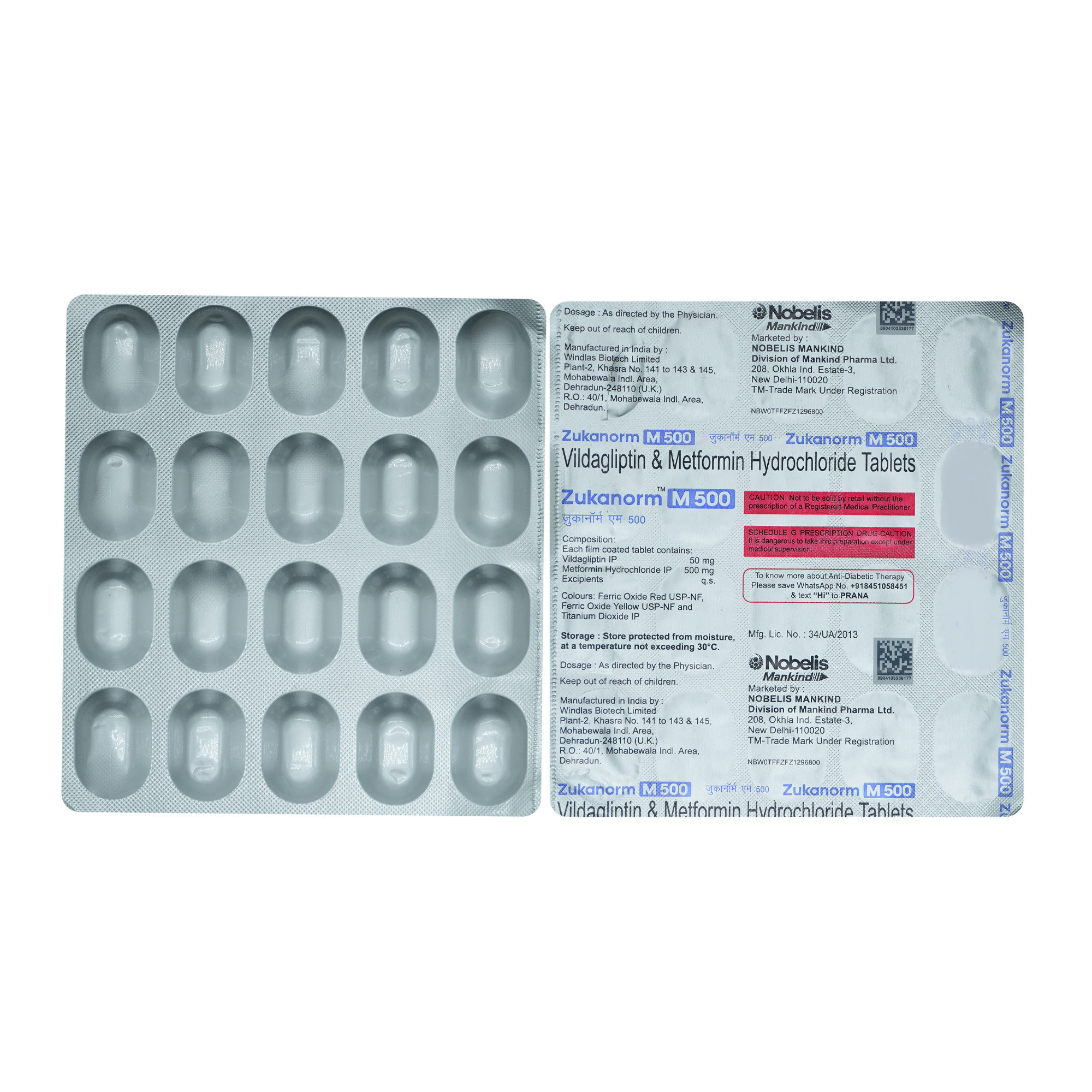Vildamac M 50/500 Tablet 15's
MRP ₹170
(Inclusive of all Taxes)
₹25.5 Cashback (15%)
Provide Delivery Location
Online payment accepted
 Prescription drug
Prescription drugWhats That
Composition :
Manufacturer/Marketer :
Consume Type :
Expires on or after :
Return Policy :
About Vildamac M 50/500 Tablet
Vildamac M 50/500 Tablet is a combination drug of Vildagliptin (DPP-4 inhibitor) and Metformin (Biguanides) belongs to the class of anti-diabetic. Type 2 diabetes mellitus used to be known as 'non-insulin-dependent diabetes mellitus (NIDDM)' or 'maturity-onset diabetes. Type 2 diabetes develops if the body does not produce enough insulin or when your body's insulin does not work as well as it should. It can also develop if the body produces too much glucagon. Insulin is a substance which helps to lower the level of sugar in your blood, especially after meals. Vildamac M 50/500 Tablet is another substance which triggers the production of sugar by the liver, causing the blood sugar to rise. The pancreas makes both of these substances.
Vildamac M 50/500 Tablet helps to control the blood sugar level. It works by making the pancreas produce insulin and less glucagon (effect of vildagliptin) and also by helping the body to make better use of the insulin it has (effect of metformin). You must continue following the diet and exercise recommended for you whilst on treatment with Vildamac M 50/500 Tablet . Vildamac M 50/500 Tablet is not a substitute for insulin. It is not used to treat type 1 diabetes (where your body does not produce insulin) or diabetic ketoacidosis.
Vildamac M 50/500 Tablet should be taken with food to avoid an upset stomach. Vildamac M 50/500 Tablet should be taken at the same time of the day each time for best results. For better advice, your doctor will decide what dose should be taken, which can change quickly depending on your condition. The most common side effect of Vildamac M 50/500 Tablet is hypoglycemia (low blood glucose levels) characterised by dizziness, sweating, palpitations, hunger pangs, dry mouth and skin etc. So, to avoid hypoglycemia, you should not miss meals and also should carry some form of sugar along with you. Other side effects include taste change, nausea, diarrhoea, stomach pain, headache, and upper respiratory symptoms.
Vildamac M 50/500 Tablet should not be stopped even if you feel better without consulting your doctor as sugar levels change. If you stop taking Vildamac M 50/500 Tablet abruptly, it may increase your sugar levels which could further increase the risk of eyesight loss (retinopathy), kidney (nephropathy) and nerve damage (neuropathy). Vildamac M 50/500 Tablet should not be taken if you have type 1 diabetes mellitus or severe kidney or liver disease. Please inform your doctor if you have any heart disease or planning to get pregnant or breastfeed.
Uses of Vildamac M 50/500 Tablet
Directions for Use
Key Benefits
Vildamac M 50/500 Tablet helps your pancreas produce more insulin, effectively utilise insulin, and decrease the excess sugar that your liver makes. It helps control the rise of blood sugar levels in your body after a meal. Vildamac M 50/500 Tablet plays a vital role in controlling blood sugar levels and prevents serious complications of diabetes like eyesight loss (retinopathy), kidney (nephropathy), nerve damage (neuropathy), diabetic foot ulcer and delayed wound healing.
Storage
- Inform your doctor about the symptoms you're experiencing due to medication.
- Your doctor may adjust your treatment plan, which could include changing your medication, adding new medications, or offering advice on managing your symptoms.
- Practice good hygiene, including frequent handwashing, avoiding close contact with others, and avoiding sharing utensils or personal items.
- Stay hydrated by drinking plenty of fluids to help loosen and clear mucus from your nose, throat, and airways.
- Get plenty of rest and engage in stress-reducing activities to help your body recover. If your symptoms don't subside or worsen, consult your doctor for further guidance.
- Inform your doctor about the common cold symptoms you're experiencing due to medication.
- Your doctor may adjust your treatment plan, which could include changing your medication, adding new medications, or offering advice on managing your symptoms.
- Practice good hygiene, including frequent handwashing, avoiding close contact with others, and avoiding sharing utensils or personal items.
- Drink plenty of fluids, such as warm water or soup, to help thin out mucus.
- Get plenty of rest and engage in stress-reducing activities to help your body recover. If your symptoms don't subside or worsen, consult your doctor for further guidance.
- Inform your doctor about dizziness symptoms. They may adjust your medication regimen or prescribe additional medications to manage symptoms.
- Follow your doctor's instructions for taking medication, and take it at the same time every day to minimize dizziness.
- When standing up, do so slowly and carefully to avoid sudden dizziness.
- Avoid making sudden movements, such as turning or bending quickly, which can exacerbate dizziness.
- Drink plenty of water throughout the day to stay hydrated and help alleviate dizziness symptoms.
- If you're feeling dizzy, sit or lie down and rest until the dizziness passes.
- Track when dizziness occurs and any factors that may trigger it, and share this information with your doctor to help manage symptoms.
- Hydrate your body: Drink enough water to prevent dehydration and headaches.
- Calm Your Mind: Deep breathing and meditation can help you relax and relieve stress.
- Rest and Recharge: Sleep for 7-8 hours to reduce headache triggers.
- Take rest: lie down in a quiet, dark environment.
- Cold or warm compresses can help reduce tension.
- Stay Upright: Maintain good posture to keep symptoms from getting worse.
- To treat headaches naturally, try acupuncture or massage therapy.
- Over-the-counter pain relievers include acetaminophen and ibuprofen.
- Prescription Assistance: Speak with your doctor about more substantial drug alternatives.
- Severe Headaches: Seek emergency medical assistance for sudden, severe headaches.
- Frequent Headaches: If you get reoccurring headaches, consult your doctor.
- Headaches with Symptoms: Seek medical attention if your headaches include fever, disorientation, or weakness.
- Notify your doctor immediately if you experience tremors or involuntary shaking after taking medication or adjusting your medication regimen.
- Your doctor may adjust your medication regimen or recommend alternative techniques like relaxation, meditation, or journaling to alleviate tremor symptoms.
- Your doctor may direct you to practice stress-reducing techniques, such as deep breathing exercises, yoga, or journaling.
- Regular physical activity, such as walking or jogging, can help reduce anxiety and alleviate tremor symptoms.
- Your doctor may recommend lifestyle changes, such as avoiding caffeine, getting enough sleep, and staying hydrated, to help manage tremors.
- Maintain regular follow-up appointments with your doctor to monitor tremor symptoms and adjust treatment plans as needed.
- Preventing Vomiting (Before it Happens)
- Take medication exactly as prescribed by your doctor. This can help minimize side effects, including vomiting.
- Having a small meal before taking your medication can help reduce nausea and vomiting.
- Talk to your doctor about taking anti-nausea medication along with your prescribed medication.
- Managing Vomiting (If it Happens)
- Try taking ginger in the form of tea, ale, or candy to help alleviate nausea and vomiting.
- What to Do if Vomiting Persists
- Consult your doctor if vomiting continues or worsens, consult the doctor for guidance on adjusting your medication or additional treatment.
- Inform Your Doctor: Notify your doctor immediately about your diarrhoea symptoms. This allows them to adjust your medication or provide guidance on managing side effects.
- Stay Hydrated: Drink plenty of fluids to replace lost water and electrolytes. Choose water, clear broth, and electrolyte-rich drinks. Avoid carbonated or caffeinated beverages to effectively rehydrate your body.
- Follow a Bland Diet: Eat easy-to-digest foods to help firm up your stool and settle your stomach. Try incorporating bananas, rice, applesauce, toast, plain crackers, and boiled vegetables into your diet.
- Avoid Trigger Foods: Steer clear of foods that can worsen diarrhoea, such as spicy, fatty, or greasy foods, high-fibre foods, and dairy products (especially if you're lactose intolerant).
- Practice Good Hygiene: Maintain good hygiene to prevent the spread of infection. To stay healthy, wash your hands frequently, clean and disinfect surfaces regularly, and avoid exchanging personal belongings with others.
- Take Anti-Diarrheal Medications: If your doctor advises, anti-diarrheal medications such as loperamide might help manage diarrhoea symptoms. Always follow your doctor's directions.
- Keep track of your diarrhoea symptoms. If they don't get better or worse or are accompanied by severe stomach pain, blood, or dehydration signs (like extreme thirst or dark urine), seek medical help.
Drug Warnings
Vildamac M 50/500 Tablet should not be used in patients with type 1 diabetes or with diabetic ketoacidosis. Some diabetic patients, while taking Vildamac M 50/500 Tablet , might develop a rare but serious condition called lactic acidosis. In this condition, there is too much lactic acid accumulated in the blood that can damage the working of your liver and kidney required for the elimination of excess lactic acid from the blood. Before you start taking Vildamac M 50/500 Tablet , tell your doctor if you’ve ever had pancreatitis (inflammation of the pancreas), kidney disease, and low vitamin B12 level. Vildamac M 50/500 Tablet , when used with insulin, may extremely lower the blood sugar level leading to hypoglycaemia condition, which can be fatal. In this case, your doctor may adjust the dose by lowering the dose of insulin or Vildamac M 50/500 Tablet . Prolonged intake of Vildamac M 50/500 Tablet may lower your thyroid-stimulating hormone (TSH); hence, an annual check-up of TSH is recommended. In rare cases, you may also develop a serious skin reaction known as bullous pemphigoid that requires immediate medical attention. Tell your doctor if you are going to have a diagnostic test with an injection of dye or X-ray contrast agent. The use of Vildamac M 50/500 Tablet should be stopped for a short time before having an X-ray procedure.
Drug-Drug Interactions
Drug-Drug Interactions
Login/Sign Up
Co-administration of Vildamac M 50/500 Tablet and Iodamide can increase the risk of lactic acidosis (when the body produces too much lactic acid).
How to manage the interaction:
Taking Vildamac M 50/500 Tablet with Iodamide is generally avoided as it can result in an interaction, please consult your doctor before taking it.
Co-administration of Vildamac M 50/500 Tablet and Iobenzamic acid can increase the risk of lactic acidosis (when the body produces too much lactic acid).
How to manage the interaction:
Taking Vildamac M 50/500 Tablet with Iobenzamic acid is generally avoided as it can result in an interaction, please consult your doctor before taking it.
Co-administration of Vildamac M 50/500 Tablet with Metrizamide together can cause the risk of lactic acidosis (when the body produces too much lactic acid ).
How to manage the interaction:
Taking Vildamac M 50/500 Tablet with Metrizamide is generally avoided as it can possibly result in an interaction, it can be taken if a doctor has advised it. However, if you experience headaches, muscle cramps or pain, contact a doctor immediately. Do not discontinue any medications without consulting a doctor.
Co-administration of Iopydol with Vildamac M 50/500 Tablet can increase the risk of side effects.
How to manage the interaction:
Taking Vildamac M 50/500 Tablet with Iopydol is not recommended, please consult your doctor before taking it.
Co-administration of Vildamac M 50/500 Tablet and Iocarmic acid can increase the risk of lactic acidosis (when the body produces too much lactic acid).
How to manage the interaction:
Taking Vildamac M 50/500 Tablet with Iocarmic acid is generally avoided as it can result in an interaction. please consult your doctor before taking it.
Co-administration of Iodixanol with Vildamac M 50/500 Tablet can increase the risk of side effects.
How to manage the interaction:
Taking Vildamac M 50/500 Tablet with Iodixanol is not recommended, please consult a doctor before taking it. Do not discontinue the medications without consulting a doctor.
Co-administration of Vildamac M 50/500 Tablet and Iobitridol can increase the risk of lactic acidosis (when the body produces too much lactic acid).
How to manage the interaction:
Taking Vildamac M 50/500 Tablet with Iobitridol is generally avoided as it can result in an interaction. Please consult your doctor before taking it.
Co-administration of Ioversol with Vildamac M 50/500 Tablet can increase the risk of side effects.
How to manage the interaction:
Taking Vildamac M 50/500 Tablet with Ioversol is not recommended, please consult your doctor before taking it.
Co-administration of Iopamidol with Vildamac M 50/500 Tablet can increase the risk of side effects.
How to manage the interaction:
Taking Vildamac M 50/500 Tablet with Iopamidol is not recommended, please consult a doctor before taking it. Do not discontinue the medications without consulting a doctor.
Co-administration of Iotroxic acid with Vildamac M 50/500 Tablet can increase the risk of side effects.
How to manage the interaction:
Taking Vildamac M 50/500 Tablet with Iotroxic acid is not recommended, please consult your doctor before taking it.
Drug-Food Interactions
Drug-Food Interactions
Login/Sign Up
Diet & Lifestyle Advise
- Fill your half plate with starchy veggies, a quarter with proteins, and a quarter with whole grain.
- Eat at regular intervals. Do not take a long gap between a meal or snack.
- Monitor your blood sugar level regularly, especially when there are lots of fluctuations.
- Invest at least 150 minutes of moderate-intensity physical activity or one hour and 15 minutes of high-intensity exercise weekly.
- Lose weight gradually to achieve a healthy body mass index (18.5 to 24.9).
- Replace refined carbohydrates-containing foods with whole grain foods and increase the intake of fruits, veggies, and other fibre-enriched foods.
- Limit saturated fat (or hidden intake fats) in food like chips, crisps, pastries, biscuits, and samosas. Choose omega-3 fatty acid-containing oils for daily cooking. For frying, you can use palm oil, mustard oil, groundnut oil, rice bran oil, and safflower oil.
- Do not take stress as it may elevate your blood sugar level. You can adopt stress management techniques like mindfulness to control stress-related blood sugar changes.
- Opt for low-fat dairy products (low-fat yoghurt, fat-free milk, cheese, etc.).
- Keep your blood pressure as normal (140/90) as possible as it reduces the risk of cardiovascular diseases in diabetes patients.
Side Effects of Vildamac M 50/500 Tablet
- Low blood sugar
- Nausea
- Headache
- Shaking or quivering
- Vomiting
- Diarrhoea
- Abdominal pain
- Loss of appetite
- Joint pain
- Tiredness
- Constipation
- Swollen hands
- Ankle or feet (oedema)
Habit Forming
Therapeutic Class
All Substitutes & Brand Comparisons
RX
Zukanorm M 500 Tablet 20's
Mankind Pharma Pvt Ltd
₹168
(₹7.56 per unit)
25% CHEAPERRX
Gliptagreat M 500/50mg Tablet 10's
Mankind Pharma Pvt Ltd
₹84
(₹7.57 per unit)
25% CHEAPERRX
Torglip M 50/500 Tablet 10's
Torrent Pharmaceuticals Ltd
₹103.5
(₹9.32 per unit)
8% CHEAPER
Author Details
We provide you with authentic, trustworthy and relevant information
Drug-Diseases Interactions
Drug-Diseases Interactions
Login/Sign Up
FAQs
Drug-Drug Interactions Checker List
- RANOLAZINE
- CIMETIDINE
- NIFEDIPINE
- ENALAPRIL
- LOSARTAN
- DICLOFENAC
Special Advise
Contact your doctor immediately if you have nausea, vomiting, kussmaul breathing (laboured and deep), and generalised weakness which are symptoms of Lactic acidosis, a very rare but serious metabolic complication.
Disease/Condition Glossary
Type 2 diabetes is a condition where the body is unable to make sufficient insulin, or the insulin that it makes doesn't work properly or is utilized by our body. This can cause high blood sugar levels (hyperglycaemia). Symptoms of type 2 diabetes include increased thirst, frequent urination at night, slow wound healing, increased hunger, fatigue, and blurred vision. There may be weight gain in some cases, while in rare cases, weight loss may be observed. The complication of type 2 diabetes also includes neuropathy (nerve problems), nephropathy (kidney problems), retinopathy (damaged retina of eyes or blindness), loss of limbs, sexual dysfunction, and an increase in the chance of heart attack or stroke.

Have a query?
Alcohol
Safe if prescribed
It is best to avoid alcohol while taking medication.
Pregnancy
Consult your doctor
Please consult your doctor for advice before using Vildamac M 50/500 Tablet .
Breast Feeding
Consult your doctor
Please consult your doctor for advice before using Vildamac M 50/500 Tablet .
Driving
Safe if prescribed
Drive only if you are physically stable and mentally focussed, If you experience drowsiness after taking these medications you should not drive or operate any machinery or vehicles.
Liver
Consult your doctor
If u have or had history or evidence of any liver-related diseases, please consult the doctor before taking the medicine.
Kidney
Consult your doctor
If u have or had history or evidence of any kidney-related diseases, please consult the doctor before taking the medicine.
Children
Safe if prescribed
It is advisable to consult a doctor before using it.
Recommended for a 30-day course: 2 Strips






























